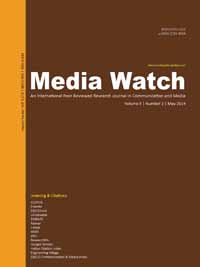Fictional Depictions of Youth in School in Films made in China and United States
Subscribe/Renew Journal
This study discussed the differences between Chinese youth film and American teen film through the perspective on cultural foundation. The authors argue that Confucianism was an alternative that greatly affects the depiction of young characters and the causal relationship of morality and fate of the characters in films. The objective of such a comparison was not to advocate for either Chinese or American youth cinema in portraying young people, but to promote a better understanding of the strengths and impacts of youth cinema and youth genre. In addition, this study examined cinematic depictions of young characters portrayed in Chinese youth films and American teen films. It was argued that Chinese youth films and American youth films differ in depictions of school settings and even their purposes.
Keywords
Youth Cinema, Chinese-Language Cinema, American Cinema, Sexual Representation, School Setting, Youth Genre.
Subscription
Login to verify subscription
User
Font Size
Information
- Bell, D. A. (2010). China's New Confucianism: Politics and Everyday Life in a Changing Society. Princeton: Princeton University Press.
- Bettis, P. J., & Adams, N. G. (2008). Geographies Of Girlhood: Identities In-between. Mahwah: Taylor & Francis.
- Cornelius, S., & Smith, I. H. (2002). New Chinese Cinema: Challenging Representations. London: Wallflower Press.
- Driscoll, C. (2011). Teen Film: A Critical Introduction. Oxford: Berg.
- Epstein, I. (2007). Recapturing the Personal: Essays on Education and Embodied Knowledge in Comparative Perspective. Charlotte: IAP-Informationa Age Publishing.
- Farber, P., Provenzo, E. F., & Holm, G. (1994). Schooling in the Light of Popular Culture. Albany: State University of New York Press.
- Gelder, K. (2000). The Horror Reader. London: Routledge.
- Hoobler, D., & Hoobler, T. (2009). Confucianism. New Tork: Infobase Publishing.
- Kaizuka, S. (2002). Confucius: His Life and Thought. London: Courier Dover Publications.
- Kaklamanidou, B. (2013). Genre, Gender and the Effects of Neoliberalism: The New Millennium Hollywood rom com. Abingdon: Routledge.
- Lamb, M. E. (2010). The Role of the Father in Child Development. Hoboken: John Wiley & Sons.
- Littlejohn, R. L. (2011). Confucianism: An Introduction. New York: I.B. Tauris.
- Madsen, R., & Strong, T. B. (2003). The Many and the One: Religious and Secular Perspectives on Ethical Pluralism in the Modern World. Princeton: Princeton University Press.
- Rosenlee, L. H. L. (2006). Confucianism and Women: A Philosophical Interpretation. Albany: State University of New York Press.
- Ruan, F. F. (1991) Sex in China: Studies in Sexology in Chinese Culture. New York: Pleum Press.
- Sealey, K. S. (2008). Film, Politics, & Education: Cinematic Pedagogy Across the Disciplines. New York: Peter Lang Publishing.
- Shary, T. (2002). Generation Multiplex: The Image of Youth in Contemporary American Cinema. Austin: University of Texas Press.
- Shary, T. (2005). Teen Movies: American Youth on Screen. London: Wallflower Press.
- Szeto, K. Y. (2011) The Martial Arts Cinema of the Chinese Diaspora: Ang Lee, John Woo, and Jackie Chan in Hollywood. Carbondale: Southern Illinois University Press.
- Thims, L. (2007). Human Chemistry (Volume Two). Morrisville: LuLu Enterprises.
- Tu, W. M. (1985). Confucian Thought: Selfhood As Creative Transformation. Albany: State University of New York Press.
- Wang, L. Z. (2011). Chinese Women's Cinema: Transnational Contexts. New York: Columbia University Press.
- Yu, E. (2011). The Renaissance of Confucianism in Contemporary China. Dordrecht: Springer.
- Zhao, Y. X. (2007). Father And Son in Confucianism And Christianity: A Comparative Study of Xunzi and Paul. Oregon: Sussex Academic Press.
- Zhou, X. L. (2007). Young Rebels in Contemporary Chinese Cinema. Hong Kong: Hong Kong University Press.

Abstract Views: 735

PDF Views: 2



